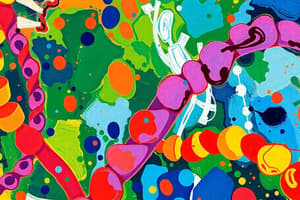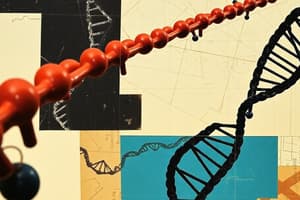Podcast
Questions and Answers
What direction does RNA polymerase synthesize RNA?
What direction does RNA polymerase synthesize RNA?
- N to C
- C to N
- 5' to 3' (correct)
- 3' to 5'
What is the function of DNA helicase?
What is the function of DNA helicase?
- Unwind part of the DNA (correct)
- Set a piece for replication to occur in the lagging strand
- Cut DNA at certain areas
- Perform the replication of DNA
Which one of the following statements is true?
Which one of the following statements is true?
- mRNA contains a template for protein synthesis (correct)
- RNA forms B-type structures
- New strands of DNA are copied 3' to 5'
- tRNA combines with proteins to form the machinery for protein synthesis (correct)
What is the role of DNA topoisomerase in DNA replication?
What is the role of DNA topoisomerase in DNA replication?
Where is the site of transcription?
Where is the site of transcription?
Which of the following are characteristic of a bacterial genome?
Which of the following are characteristic of a bacterial genome?
According to the Central Dogma of molecular biology, which of the following forms of synthesis is NOT possible:
According to the Central Dogma of molecular biology, which of the following forms of synthesis is NOT possible:
Which of the following best describes epigenetics?
Which of the following best describes epigenetics?
Which proteins are involved in RNA transcription?
Which proteins are involved in RNA transcription?
Which enzyme is responsible for replacing RNA primers with DNA on the lagging strand during DNA replication?
Which enzyme is responsible for replacing RNA primers with DNA on the lagging strand during DNA replication?
Based on the central dogma of molecular biology, genetic material cannot undergo:
Based on the central dogma of molecular biology, genetic material cannot undergo:
Which one is a nucleobase that can only be found in RNA?
Which one is a nucleobase that can only be found in RNA?
When comparing the melting temperatures of two pieces of DNA, why would one DNA have a higher melting temperature than the other?
When comparing the melting temperatures of two pieces of DNA, why would one DNA have a higher melting temperature than the other?
What type of single point mutation would never impact protein structure?
What type of single point mutation would never impact protein structure?
What wavelength do proteins usually absorb most strongly?
What wavelength do proteins usually absorb most strongly?
During DNA replication, which enzyme is responsible for preventing DNA supercoiling after the double stranded helix is unwound?
During DNA replication, which enzyme is responsible for preventing DNA supercoiling after the double stranded helix is unwound?
Flashcards
RNA polymerase direction
RNA polymerase direction
RNA polymerase synthesizes RNA in the 5' to 3' direction.
DNA helicase function
DNA helicase function
DNA helicase unwinds the DNA double helix during DNA replication.
tRNA role in protein synthesis
tRNA role in protein synthesis
tRNA combines with proteins to form a machinery for protein synthesis.
DNA topoisomerase function
DNA topoisomerase function
Signup and view all the flashcards
Transcription site
Transcription site
Signup and view all the flashcards
Bacterial genome characteristics
Bacterial genome characteristics
Signup and view all the flashcards
Epigenetics definition
Epigenetics definition
Signup and view all the flashcards
RNA transcription proteins
RNA transcription proteins
Signup and view all the flashcards
DNA polymerase I role
DNA polymerase I role
Signup and view all the flashcards
Reverse transcription definition
Reverse transcription definition
Signup and view all the flashcards
Study Notes
BIOL1X07 Revision Quiz Questions 2021
- Course: From Molecules to Ecosystems (University of Sydney)
- Format: Multiple choice questions from BIOL1X07 students.
- Use: Revision resource for BIOL1X07 students.
Module 1: Information Transfer
-
Question 1: What direction does RNA polymerase synthesise RNA?
- 5' to 3'
-
Question 2: What is the function of DNA helicase?
- Unwind part of the DNA to allow replication.
- Sets a piece for replication on the lagging strand.
-
Question 3: Which statements are true?
- RNA forms B-type structures.
- mRNA contains the template for protein synthesis.
- tRNA combines with proteins to form machinery for protein synthesis.
-
Question 4: What is the role of DNA topoisomerase in DNA replication?
- Prevents supercoiling of DNA.
-
Question 5: Where is the site of transcription?
- Nucleus
-
Question 6: If 2 genetic bases were used instead of 4 how long would codons need to be to code for all 20 amino acids?
- 5
-
Question 7: Which characteristics describe a bacterial genome?
- Large genomes (~10Mb - 150GB).
- Circular chromosomes.
-
Question 8: According to the Central Dogma of molecular biology, which synthesis is not possible?
- RNA to DNA
Module 2: Energy Systems & Cells
-
Question 22: Which statement is true for CAM photosynthesis?
- Temporal separation occurs; stomata open at night and closed during the day.
-
Question 23: In Krebs cycle, a six carbon compound from acetyl CoA is…
- Citric acid.
-
Question 24: Where does glycolysis occur?
- Cytosol
-
Question 25: Which is true regarding photosynthesis?
- C4 photosynthesis is more water-efficient than CAM photosynthesis.
-
Question 26: Which type of photosynthesis is the most water-efficient?
- CAM photosynthesis.
-
Question 27: Which of the following does NOT demonstrate plant respiration flexibility?
- Using CAM photosynthesis in dry habitats to limit water loss.
-
Question 28: What is the primary purpose of Alternative Oxidase and the uncoupling protein?
- To prevent possible damage to the electron transport chain.
-
Question 29: How many photosystems are involved in non-cyclic phosphorylation?
- 2
-
Question 30: Why is Rubisco's oxygenase activity problematic?
- Oxygenation produces a waste product which cannot enter the Calvin cycle and is energetically expensive to deal with.
-
Question 31: What is the difference between C3 and C4 photosynthesis?
- C3 produce a three carbon compound via Calvin Cycle, while C4 make intermediate four-carbon compound that splits into three carbon compound for Calvin cycle.
-
Question 32: What metabolic pathways do autotrophs and heterotrophs both share?
- Glycolysis and oxidative phosphorylation
-
Question 33: What is one difference between the light dependent and light independent reactions in photosynthesis?
- Light dependent produces oxygen, Light independent produces glucose.
-
Question 34: What is the major evolutionary event that maximized light capture by plants?
- Using sunlight to make both ATP and NADPH.
Module 3: Global Health
-
Question 74: Why use E.coli as a host instead of yeast?
- Fastest growth.
- Easy to extract.
- Better for expressing eukaryotic genes.
- Recognized as safe.
-
Question 75: Which statements is correct regarding agar plates?
- Mannitol Salt Agar is Differential and Enriched.
-
Question 76: Which bacteria can grow well in cold temperatures?
- Listeria.
-
Question 77: Which group of organisms accounts for the greatest proportion of global diversity? - Bacteria.
-
Question 78: Soil sample colony count calculation.
- 1.14 x 108 CFU.
-
Question 79: What were the contributions of Howard Florey and Ernst Chain regarding penicillin?
- Purified penicillin and found it could cure mice of bacterial infection.
-
Question 80: Which of the following is not a microbial heterotroph?
- Methanotrophs.
Studying That Suits You
Use AI to generate personalized quizzes and flashcards to suit your learning preferences.



